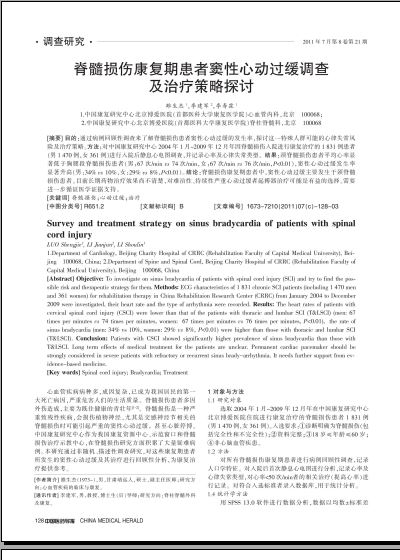脊髓损伤康复期患者窦性心动过缓调查及治疗策略探讨(3)
 |
| 第1页 |
参见附件(3116KB,3页)。
[7]Schulz-Stübner S. The use of small-dose theophylline for the treatment of bradycardia in patients with spinal cord injury [J]. Anesth Analg,2005,101(6):1809-1810.
[8]Piepmeier JM, Lehman KB, Lane JG. Cardiovascular instability following acute cervical spinal cord trauma [J]. Cent Nerv Syst Trauma,1985,2(6):153-160.
[9]Winslow EB, Lesch M, Talano JV, et al. Spinal cord injuries associated with cardiopulmonary complications [J]. Spine,1986,11(8):809-812.
[10]Gilgoff IS, Ward SL, Hohn AR. Cardiac pacemaker in high spinal cord injury [J]. Arch Phys Med Rehabil,1991,72(8):601-603.
[11]Franga DL, Hawkins ML, Medeiros RS, et al. Recurrent asystole resulting from high cervical spinal cord injuries [J]. Am Surg,2006,72(6):525-529.
[12]Sanghvi AV, Chhabra HS, Nigam V, et al. Permanent cardiac pacemaker for cardiac arrest following cervico-dorsal spinal injury [J]. Eur Spine J,2009,18(Suppl 2):254-257.
[13]Rangappa P, Jeyadoss J, Flabouris A, et al. Cardiac pacing in patients with a cervical spinal cord injury [J]. Spinal Cord,2010,48(12):867-871.
(收稿日期:2011-03-08)
您现在查看是摘要介绍页,详见PDF附件(3116KB,3页)。